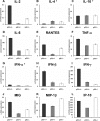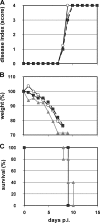Role of hypercytokinemia in NF-kappaB p50-deficient mice after H5N1 influenza A virus infection
- PMID: 18768968
- PMCID: PMC2573282
- DOI: 10.1128/JVI.01071-08
Role of hypercytokinemia in NF-kappaB p50-deficient mice after H5N1 influenza A virus infection
Abstract
During H5N1 influenza virus infection, proinflammatory cytokines are markedly elevated in the lungs of infected hosts. The significance of this dysregulated cytokine response in H5N1-mediated pathogenesis remains to be determined. To investigate the influence of hypercytokinemia, or "cytokine storm," a transgenic mouse technology was used. The classical NF-kappaB pathway regulates the induction of most proinflammatory cytokines. Deletion of the p50 subunit leads to a markedly reduced expression of the NF-kappaB-regulated cytokines and chemokines. Here we show that H5N1 influenza virus infection of this transgenic mouse model resulted in a lack of hypercytokinemia but not in altered pathogenesis.
Figures



Similar articles
-
CLEC5A-Mediated Enhancement of the Inflammatory Response in Myeloid Cells Contributes to Influenza Virus Pathogenicity In Vivo.J Virol. 2016 Dec 16;91(1):e01813-16. doi: 10.1128/JVI.01813-16. Print 2017 Jan 1. J Virol. 2016. PMID: 27795434 Free PMC article.
-
Autophagy mediates avian influenza H5N1 pseudotyped particle-induced lung inflammation through NF-κB and p38 MAPK signaling pathways.Am J Physiol Lung Cell Mol Physiol. 2014 Jan;306(2):L183-95. doi: 10.1152/ajplung.00147.2013. Epub 2013 Nov 15. Am J Physiol Lung Cell Mol Physiol. 2014. PMID: 24242010
-
Inhibition of the cytokine response does not protect against lethal H5N1 influenza infection.Proc Natl Acad Sci U S A. 2007 Jul 24;104(30):12479-81. doi: 10.1073/pnas.0705289104. Epub 2007 Jul 17. Proc Natl Acad Sci U S A. 2007. PMID: 17640882 Free PMC article.
-
[Cytokine storm in avian influenza].Mikrobiyol Bul. 2008 Apr;42(2):365-80. Mikrobiyol Bul. 2008. PMID: 18697437 Review. Turkish.
-
The role of influenza A virus-induced hypercytokinemia.Crit Rev Microbiol. 2022 Mar;48(2):240-256. doi: 10.1080/1040841X.2021.1960482. Epub 2021 Aug 5. Crit Rev Microbiol. 2022. PMID: 34353210 Review.
Cited by
-
miR-221/222 targets adiponectin receptor 1 to promote the epithelial-to-mesenchymal transition in breast cancer.PLoS One. 2013 Jun 11;8(6):e66502. doi: 10.1371/journal.pone.0066502. Print 2013. PLoS One. 2013. PMID: 23776679 Free PMC article.
-
β-sitosterol ameliorates influenza A virus-induced proinflammatory response and acute lung injury in mice by disrupting the cross-talk between RIG-I and IFN/STAT signaling.Acta Pharmacol Sin. 2020 Sep;41(9):1178-1196. doi: 10.1038/s41401-020-0403-9. Epub 2020 Jun 5. Acta Pharmacol Sin. 2020. PMID: 32504068 Free PMC article.
-
Infection with influenza A viruses causes changes in promoter DNA methylation of inflammatory genes.Influenza Other Respir Viruses. 2013 Nov;7(6):979-86. doi: 10.1111/irv.12127. Epub 2013 Jun 11. Influenza Other Respir Viruses. 2013. PMID: 23758996 Free PMC article.
-
Influenza A viruses target type II pneumocytes in the human lung.J Infect Dis. 2012 Dec 1;206(11):1685-94. doi: 10.1093/infdis/jis455. Epub 2012 Jul 24. J Infect Dis. 2012. PMID: 22829640 Free PMC article.
-
Host Response Comparison of H1N1- and H5N1-Infected Mice Identifies Two Potential Death Mechanisms.Int J Mol Sci. 2017 Jul 27;18(8):1631. doi: 10.3390/ijms18081631. Int J Mol Sci. 2017. PMID: 28749409 Free PMC article.
References
-
- Akdis, C. A., T. Blesken, M. Akdis, S. S. Alkan, C. H. Heusser, and K. Blaser. 1997. Glucocorticoids inhibit human antigen-specific and enhance total IgE and IgG4 production due to differential effects on T and B cells in vitro. Eur. J. Immunol. 272351-2357. - PubMed
-
- Beigel, J. H., J. Farrar, A. M. Han, F. G. Hayden, R. Hyer, M. D. de Jong, S. Lochindarat, T. K. Nguyen, T. H. Nguyen, T. H. Tran, A. Nicoll, S. Touch, and K. Y. Yuen. 2005. Avian influenza A (H5N1) infection in humans. N. Engl. J. Med. 3531374-1385. - PubMed
-
- Bonizzi, G., and M. Karin. 2004. The two NF-kappaB activation pathways and their role in innate and adaptive immunity. Trends Immunol. 25280-288. - PubMed
-
- Chan, M. C., C. Y. Cheung, W. H. Chui, S. W. Tsao, J. M. Nicholls, Y. O. Chan, R. W. Chan, H. T. Long, L. L. Poon, Y. Guan, and J. S. Peiris. 2005. Proinflammatory cytokine responses induced by influenza A (H5N1) viruses in primary human alveolar and bronchial epithelial cells. Respir. Res. 6135. - PMC - PubMed
Publication types
MeSH terms
Substances
LinkOut - more resources
Full Text Sources
Other Literature Sources
Medical
Molecular Biology Databases
Research Materials

